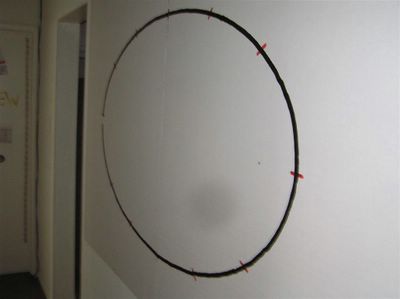Anyway I had to talk about the Ellipse today. The ellipse is a timeline of events, drawn on a 4'x6' board in on eof our walls in the house. The idea is to divide the Ellipse into 12 pieces of equal length representing the 12 months, and then put info and photos on significant events that took place throughout this time period.

Now, drawing the ellipse was no problem. I measured the horizontal and vertical dimensions (long and short axis of ellipse) and that is enough to define the foci distance and the eccentricity. Then I centered the 2 foci on the axis of the foamboard, and used a phonecord that Andrew was keeping its edges on the foci and I was drawing with a pencil. I've never constructed an ellipse before like that, and it was quite a fun.
Yet the tough part was yet to come: we had to divide the Ellipse into 12 portions of equal length. Now, it is fairly obvious that in a circle the angles of these points with respect to the center of the circle will be 0, 30, 60 and 90 degrees say (top corner quarter only). But how about an ellipse? I wrote down the path integral along the length and in turns out although it is very easy to calculate the surface area of an ellipse (πab), the circumference has no analytic expression and involves a thing called elliptical integrals! And in our case I had to solve an equation involving an elliptic integral where the unknown variable (the angle up to which to integrate) was located in the upper limit of the integral...
So 3 phd students sat down and pondered for about 15 minutes on how to calculate that (OK, we can do it in Matlab but ain't fun) and we tried all kinds of stuff. Although it's impossible to calculate the circumference of the Ellipse, maybe we could get an analytic formula for the respective angles that define pieces of equal length. At the end there seemed to be no way to do that but just then the real engineer inside Andrew's body spoke: using the same phonecord , measure the length of a quarter of the Ellipse (already drawn on the wall). The length will be 1 in phonecord units. Then fold the phonecord twice, such that there are 3 portions of equal length one of top of eachother. You can actually do that with big accuracy. Then we had a portion of phonecord of length 1/3, exactly what we needed! Then we simply placed the phonecord along the Ellipse and marked the points 2 times for that quarter. Then getting the symmetric points with respect to the axis and the center of the Ellipse was trivial work, yielding all 12 points on the Ellipse. Now this is good engineering my friends. The Ellipse looks flawless on the wall as we speak.